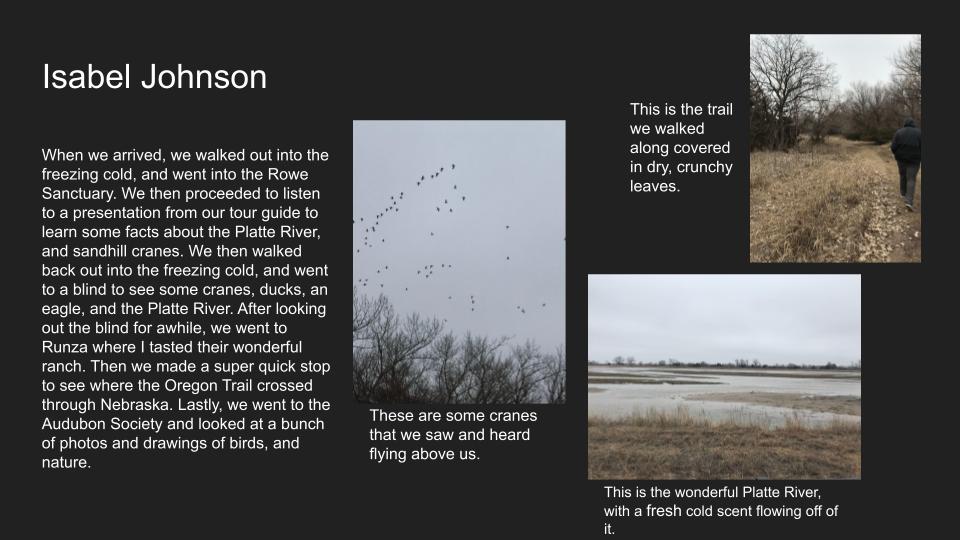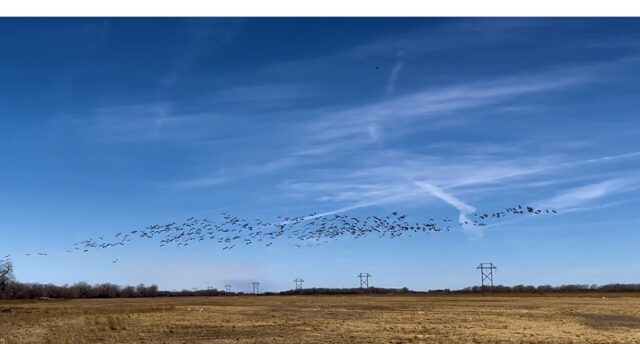A few weeks ago, Heartland’s sophomores and juniors took a field trip to the Rowe Sanctuary and the Crane Trust Nature & Visitor Center, where they witnessed the incredible migration of the Sandhill Cranes.
It’s been about 30 years since students began making this field trip which has become an annual tradition. It’s worth remembering how this longtime outdoor educational experience began and continues today.
It all started when the late longtime science teacher Kathy Jacobitz and retired English teacher Sharon Bishop conceived the field trip as a collaboration between their sophomore Biology and language arts curriculum.
“I was already having my sophomores read “Those of the Gray Wind: The Sandhill Cranes” by Paul Johnsguard as part of our Nebraska Literature unit, so it wasn’t difficult for me to imagine how we might collaborate,” said Bishop.
The idea for combining the science and language arts curriculum took off when Marc Regier was hired as the new Biology teacher in 1994.
“I’ve never canceled this field trip since I’ve been teaching here,” said Regier. “It’s so valuable as a way to use the cranes to study Nebraska Platte River habitat.”
In preparation for the crane trip, the students would watch the NET-produced “Crane Song” film and read the Johnsguard book. “At first, we used to take the kids to Crane Meadows near Alda, where there was a bridge over the Platte River to view the cranes. We didn’t get a real close look from the bridge, so a few years later, Marc found some blinds for better viewing of the cranes towards evening, which was very cool,” said Bishop.
After the field trip, the students reflected on their experiences by writing poetry and essays in their English class. In Biology, the students studied the long-term effects of environmental changes on the Platte River and why this area is vital for continued crane migration.
Eventually, the field trip morphed into an early morning trek to see the cranes–early morning, as in leaving at 5 AM. “We discovered the viewings were hit and miss in the evenings, and early mornings gave us much better odds of seeing the cranes,” said Regier.
This year the bus with about 30 Heartland students left later than the usual 5 AM due to the weather, arriving at the Rowe Sanctuary to get their first view of the cranes, according to Regier. They usually drive around, stopping at several countryside blinds and visit the Crane Center at Alda, where there are art displays and an educational presentation.
“The trip is really fluid every year, depending on what’s available and the weather,” said Regier. Some stops over the years were the Mormon Pioneer Trail, the Archway Monument at Kearney, and last year they went to the Stuhr Museum, where they viewed an exhibition featuring life-sized paintings of the cranes.
Another favorite stop is the Murdock site a few miles south of Alda, where the Wood River and Platte converge. “It’s a historical spot for the kids to see the fading ruts of the Morman Pioneer Trail,” said Regier.
He also tells his students the significance of the rivers in the early settlement of Nebraska and how 90% of Nebraska’s population lived within 30 miles of the Platte River. When Bishop was teaching Nebraska Literature, her students were reading Cather’s “My Antonia,” so this stop tied into the early immigrant experience in the book.
Bishop and Regier agreed that one of their most memorable trips was when the kids shed their shoes and ran through the Platte River on an unseasonably hot day in March. “We got in a bit of trouble on that one! The bus was a mess, but seeing everyone enjoy wading down the Platte was worth it,” said Regier.
Over the years, they’ve sighted more than cranes–bald eagles, golden eagles, beavers, deer, flocks of wild turkeys, and whooping cranes, said Regier. “My purpose in all this is I hope our kids recognize what’s good for the wildlife and the birds is good for us.”
Here’s a few samples of the pictures and writing created from this year’s field trip:





































